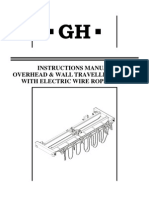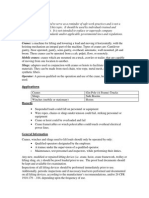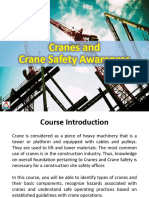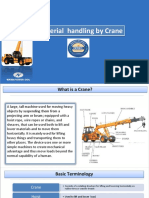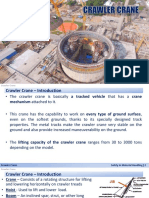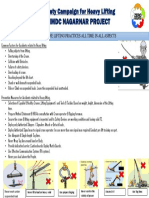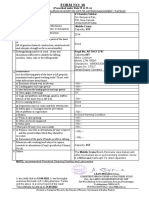0 ratings0% found this document useful (0 votes)
42 viewsSafe Crane Operations: Zero Harm - Only Safe Production
Safe Crane Operations: Zero Harm - Only Safe Production
Uploaded by
KushCranes are mechanical lifting devices used to lift and move heavy loads beyond human capability. Common crane operation hazards include improper setup, contact with power lines, overloading, safety system overrides, obstructed operator vision, mechanical failures, and operator error. Factors like poor equipment, incorrect boom angles, increased load radii, improper setup, unlevel positioning, overreaching, side loading, rapid movements, and lifting unknown weights can reduce a crane's capacity. To operate cranes safely, operators must have valid permits and lift plans, conduct inspections, ensure proper grounding, level positioning, weight verification, environmental checks, safe load control, obstruction clearance, qualified tackle inspection, and only respond to authorized signals.
Copyright:
© All Rights Reserved
Available Formats
Download as PDF, TXT or read online from Scribd
Safe Crane Operations: Zero Harm - Only Safe Production
Safe Crane Operations: Zero Harm - Only Safe Production
Uploaded by
Kush0 ratings0% found this document useful (0 votes)
42 views1 pageCranes are mechanical lifting devices used to lift and move heavy loads beyond human capability. Common crane operation hazards include improper setup, contact with power lines, overloading, safety system overrides, obstructed operator vision, mechanical failures, and operator error. Factors like poor equipment, incorrect boom angles, increased load radii, improper setup, unlevel positioning, overreaching, side loading, rapid movements, and lifting unknown weights can reduce a crane's capacity. To operate cranes safely, operators must have valid permits and lift plans, conduct inspections, ensure proper grounding, level positioning, weight verification, environmental checks, safe load control, obstruction clearance, qualified tackle inspection, and only respond to authorized signals.
Original Description:
Hse bulletin safe crane operations
Original Title
2169
Copyright
© © All Rights Reserved
Available Formats
PDF, TXT or read online from Scribd
Share this document
Did you find this document useful?
Is this content inappropriate?
Cranes are mechanical lifting devices used to lift and move heavy loads beyond human capability. Common crane operation hazards include improper setup, contact with power lines, overloading, safety system overrides, obstructed operator vision, mechanical failures, and operator error. Factors like poor equipment, incorrect boom angles, increased load radii, improper setup, unlevel positioning, overreaching, side loading, rapid movements, and lifting unknown weights can reduce a crane's capacity. To operate cranes safely, operators must have valid permits and lift plans, conduct inspections, ensure proper grounding, level positioning, weight verification, environmental checks, safe load control, obstruction clearance, qualified tackle inspection, and only respond to authorized signals.
Copyright:
© All Rights Reserved
Available Formats
Download as PDF, TXT or read online from Scribd
Download as pdf or txt
0 ratings0% found this document useful (0 votes)
42 views1 pageSafe Crane Operations: Zero Harm - Only Safe Production
Safe Crane Operations: Zero Harm - Only Safe Production
Uploaded by
KushCranes are mechanical lifting devices used to lift and move heavy loads beyond human capability. Common crane operation hazards include improper setup, contact with power lines, overloading, safety system overrides, obstructed operator vision, mechanical failures, and operator error. Factors like poor equipment, incorrect boom angles, increased load radii, improper setup, unlevel positioning, overreaching, side loading, rapid movements, and lifting unknown weights can reduce a crane's capacity. To operate cranes safely, operators must have valid permits and lift plans, conduct inspections, ensure proper grounding, level positioning, weight verification, environmental checks, safe load control, obstruction clearance, qualified tackle inspection, and only respond to authorized signals.
Copyright:
© All Rights Reserved
Available Formats
Download as PDF, TXT or read online from Scribd
Download as pdf or txt
You are on page 1of 1
RJ OIL PRODUCTION PROJECT
Zero Harm - Only Safe Production
Safe Crane Operations
A crane is a mechanical lifting device that can be used to lift vertically and lower materials; also it can
use to move materials horizontally. Typically most modern construction site cranes achieve lift by
mechanical advantage or by use of hydraulic pressure systems. Thus such cranes are able to lift and
move loads far beyond human capability.
Common Hazards in Crane Operations
• Improper Crane Setup
• Contact with overhead Power Line
• Overloading of designed lifting capability
• Overriding safety system
• Obstruction of Operator vision
• Mechanical crane failure
X
• Operator Error
Factors affect crane Capacity
• Poor equipment condition
X
• Variations / error in boom angle indicator
• Increase in load radius
• Improper crane set-up (outriggers)
• Crane not in level position
• Over reaching & side loading
• Rapid swing & impact loading
Never
Never leave the crane
• Extending boom with suspended load unattended while
• Rapid acceleration or deceleration of load running or holding load.
• Lift unknown weight being lifted & never walk or Work
• Lifting operation in bad weather conditions underneath any
(Wind speed >35km/ph, Rain sand storm etc...) suspended load
Safe Crane Operation Guidelines
• Ensure valid Permit and Lift plan available before any lift
• Operator should conduct daily crane inspection.
SLI
• Check and ensure ground conditions.
• Extend the outriggers fully & utilize proper outrigger pads.
• Place the crane in level position.
• Check the weight to be lifted and type of load.
• Check the environmental conditions.
• Never overload crane.
• Never bypass any safety system.
• Always use tag lines for suspended load control
• Check and confirm there is no obstructions around the load swing area.
• Use only inspected current quarter color coded lifting tackles
• Operator should respond only to signals from the competent signalman except
Emergency Stop Signal (which can be given by anyone).
Bulletin June 2019
You might also like
- GH - ManualDocument98 pagesGH - ManualLucile Fernandes100% (2)
- Standard Criteria 251 - Design of Guidance Systems For Lifting and PlacementDocument66 pagesStandard Criteria 251 - Design of Guidance Systems For Lifting and PlacementTien Hong DoNo ratings yet
- SOP Crane OperationDocument4 pagesSOP Crane OperationNakkolop100% (1)
- 16 Hoisting and Conveying EquipmentDocument71 pages16 Hoisting and Conveying EquipmentVenkata DineshNo ratings yet
- Seven BorealisDocument2 pagesSeven BorealisazamNo ratings yet
- 039 G HSE Bulletin Safe Crane OperationsDocument1 page039 G HSE Bulletin Safe Crane OperationsOws AnishNo ratings yet
- Lift Plan RequirementsDocument37 pagesLift Plan RequirementsBathija DevendraNo ratings yet
- Working Safely: Around Overhead CranesDocument2 pagesWorking Safely: Around Overhead CranesParth PatelNo ratings yet
- 11-Lifting OperationsDocument73 pages11-Lifting OperationsElavarasan Pavan100% (1)
- Safety AwarenessDocument43 pagesSafety AwarenessTuesday EscabarteNo ratings yet
- Training Material_Forklift OperationDocument33 pagesTraining Material_Forklift OperationShiv KumarNo ratings yet
- Mobile Crane Operator Exam OutlineDocument1 pageMobile Crane Operator Exam OutlineHermon PakpahanNo ratings yet
- Crane Safety 1Document113 pagesCrane Safety 1Parthasarathy VadapalliNo ratings yet
- 11. Lifting Inside Fabrication Shop - R&MDocument30 pages11. Lifting Inside Fabrication Shop - R&MBhabani SankarNo ratings yet
- NR 18 Haulotte Compact 10dx 2008Document20 pagesNR 18 Haulotte Compact 10dx 2008CPSSTNo ratings yet
- Slewing Jib Cranes SI 18.3Document2 pagesSlewing Jib Cranes SI 18.3reda mesbahNo ratings yet
- BR - Refresher 16.4 Crane SafetyDocument45 pagesBR - Refresher 16.4 Crane SafetySudip ShresthaNo ratings yet
- Rough Terrain Forklift Safety Part 1 Readiness Job Aid PS5-102860Document2 pagesRough Terrain Forklift Safety Part 1 Readiness Job Aid PS5-102860Rhytham SoniNo ratings yet
- Forklift SafetyDocument13 pagesForklift SafetyDamien Gracious K.DNo ratings yet
- Dozer SopDocument3 pagesDozer Soptalabira100% (1)
- Lifting PlanDocument3 pagesLifting PlanBibin JohnNo ratings yet
- Health and Safety FCX-HS32Document8 pagesHealth and Safety FCX-HS32berry trisnamuktiNo ratings yet
- Operating & Safety GuideDocument2 pagesOperating & Safety Guidelalit PatilNo ratings yet
- Safety in Mobile CranesDocument60 pagesSafety in Mobile CranesSwapnil pupulwad100% (1)
- TBT BULLETIN - Safe Operation of Dump Trucks - English PDFDocument1 pageTBT BULLETIN - Safe Operation of Dump Trucks - English PDF孔超100% (1)
- Title: 9801 High-Impact Crane Safety: Length: 18 Minutes Production Year: 1998 Program SynopsisDocument2 pagesTitle: 9801 High-Impact Crane Safety: Length: 18 Minutes Production Year: 1998 Program Synopsisg665013No ratings yet
- Material Handling by CraneDocument16 pagesMaterial Handling by Cranenitin369100% (1)
- Crawler Crane Safety in Material Handling - 1Document15 pagesCrawler Crane Safety in Material Handling - 1Kintali VinodNo ratings yet
- Heavy Lifting PostersDocument1 pageHeavy Lifting Postersjohn rajNo ratings yet
- Working On StockpilesDocument1 pageWorking On StockpilesFarah SafrinaNo ratings yet
- Crane Operator Safety Job Aid PS5-00867Document4 pagesCrane Operator Safety Job Aid PS5-00867minxymoneyNo ratings yet
- SWMS Forklift CNGDocument2 pagesSWMS Forklift CNGAkano OluwasolaNo ratings yet
- Topic 6 - Construction Machinery - Crane SafetyDocument107 pagesTopic 6 - Construction Machinery - Crane Safetypangcheat pubgNo ratings yet
- Topic 6 - Construction Machinery - Crane SafetyDocument107 pagesTopic 6 - Construction Machinery - Crane SafetyMica Joice FernandezNo ratings yet
- Farm Tractor SafetyDocument47 pagesFarm Tractor SafetySanja KrajinovicNo ratings yet
- Tipping Operations v1 PDFDocument17 pagesTipping Operations v1 PDFSaibi KhanNo ratings yet
- Haulotte Telescopic Booms 2008Document16 pagesHaulotte Telescopic Booms 2008daniel ortegaNo ratings yet
- Liftingoperationsafetyppt 230220111908 487c851eDocument39 pagesLiftingoperationsafetyppt 230220111908 487c851emamuNo ratings yet
- Powered Industrial Truck Operator Training TrainingDocument75 pagesPowered Industrial Truck Operator Training TrainingiqjreynaNo ratings yet
- Forklift Operator TrainingDocument40 pagesForklift Operator TrainingMarian RaduNo ratings yet
- Safety Moment Boom Truck SafetyDocument1 pageSafety Moment Boom Truck Safetymrjanjua66No ratings yet
- Crane Safety: Stability and Tipping: Remember ThisDocument2 pagesCrane Safety: Stability and Tipping: Remember Thismiraç burak navruzNo ratings yet
- Safe Use of Excavator As Lifting MachineDocument37 pagesSafe Use of Excavator As Lifting MachineEngr Badz de DiosNo ratings yet
- Crane Safety IS StandardsDocument22 pagesCrane Safety IS StandardsWasim Akram100% (1)
- OSHE-F-03, Toolbox Talk-Safe Lfiting OperationDocument1 pageOSHE-F-03, Toolbox Talk-Safe Lfiting OperationIbrahim EsmatNo ratings yet
- 004-18 - Forklift HazardsDocument2 pages004-18 - Forklift HazardsNeil OsenaNo ratings yet
- Crane & Hoist SafetyDocument83 pagesCrane & Hoist SafetyBatmanathan MuniandyNo ratings yet
- Tower Crane: Basuki AnondhoDocument25 pagesTower Crane: Basuki AnondhoMelik ChuNo ratings yet
- Malik Material Handling PresentationDocument47 pagesMalik Material Handling Presentationghada gattouchNo ratings yet
- Lifting and Rigging Toolbox TalkDocument1 pageLifting and Rigging Toolbox TalkKlick Media MarketingNo ratings yet
- Lifting and Rigging Training Session 1 - 2021 01 22Document25 pagesLifting and Rigging Training Session 1 - 2021 01 22ELMLEMROZI100% (1)
- Westlake Property Management: - Crane Lifting Operations Awareness TrainingDocument63 pagesWestlake Property Management: - Crane Lifting Operations Awareness TrainingElsayed HamoudaNo ratings yet
- RT02 Crawler CraneDocument5 pagesRT02 Crawler CraneHassan YoussofNo ratings yet
- Muhammad Rehan Khan Maintenance EngineerDocument13 pagesMuhammad Rehan Khan Maintenance EngineerHamza NoumanNo ratings yet
- Fork Lift PowerpointDocument46 pagesFork Lift Powerpointanwareded100% (2)
- Heavy Lift ProceduresDocument9 pagesHeavy Lift ProceduresKatie PearceNo ratings yet
- Aeiral LiftDocument28 pagesAeiral Liftdanaytesfu27No ratings yet
- 7 CIVL 4171 Week SevenDocument239 pages7 CIVL 4171 Week SevenAffaan AmirNo ratings yet
- Lifting Operation Rev2Document29 pagesLifting Operation Rev2Chong Yun QingNo ratings yet
- Forklifts Operations: 16 Simple Tips For Safety Operating of ForkliftDocument19 pagesForklifts Operations: 16 Simple Tips For Safety Operating of ForkliftCio Ion100% (1)
- Forklift Safety Guide For Operators.v1.0Document2 pagesForklift Safety Guide For Operators.v1.0tubyyy951No ratings yet
- d001752 PDFDocument3 pagesd001752 PDFSermsakNo ratings yet
- The Instant Handbook of Boat Handling, Navigation, and Seamanship: A Quick-Reference Guide for Sail and PowerFrom EverandThe Instant Handbook of Boat Handling, Navigation, and Seamanship: A Quick-Reference Guide for Sail and PowerRating: 5 out of 5 stars5/5 (1)
- WP IndustrialHelmetaccordingtoEN397 GB 1Document2 pagesWP IndustrialHelmetaccordingtoEN397 GB 1KushNo ratings yet
- Environment Day Oath PDFDocument1 pageEnvironment Day Oath PDFKushNo ratings yet
- Curriculum Vitae: Post Applied: Safety Engineer / Safety SupervisorDocument4 pagesCurriculum Vitae: Post Applied: Safety Engineer / Safety SupervisorKushNo ratings yet
- Env Aspects Abe em As 01Document2 pagesEnv Aspects Abe em As 01KushNo ratings yet
- Abu Dhabi Occupational Safety and Health System Framework (Oshad-Sf) Code of PracticeDocument10 pagesAbu Dhabi Occupational Safety and Health System Framework (Oshad-Sf) Code of PracticeKushNo ratings yet
- S - W I R: Afety Toolbox Training Ater Ntrusion EsponseDocument3 pagesS - W I R: Afety Toolbox Training Ater Ntrusion EsponseKushNo ratings yet
- BEMO Installation Guide - V1-2018Document91 pagesBEMO Installation Guide - V1-2018Anonymous wzuyBcNo ratings yet
- Chandra Sekar 12.09.2022Document1 pageChandra Sekar 12.09.2022Rammurthy JVNo ratings yet
- Lifting Plan For CB200T MatDocument8 pagesLifting Plan For CB200T MatPhú Vũ TrươngNo ratings yet
- Int 2016 01 - 09Document25 pagesInt 2016 01 - 09CHRISTIAN LOPEZ FLOREZ100% (2)
- Man Machine Interface SafetyDocument9 pagesMan Machine Interface SafetyVidyesh Viswanathan NairNo ratings yet
- Safe Work Method StatementDocument176 pagesSafe Work Method StatementMohamed Rizwan100% (2)
- Lifting Method StatementDocument22 pagesLifting Method StatementJanaka Kavinda100% (2)
- Operators Manual Load King 25-92Document259 pagesOperators Manual Load King 25-92Sauz Subestación100% (1)
- Cranes Catalog CR 1 2015 Gesamt En-1Document368 pagesCranes Catalog CR 1 2015 Gesamt En-1Sam EHcamNo ratings yet
- Load Chart Tadano Gt-550eDocument5 pagesLoad Chart Tadano Gt-550ePsdmMCCI2021 MECNo ratings yet
- Asian Hercules III Heavy Lift VesselDocument2 pagesAsian Hercules III Heavy Lift VesselPim van KapelNo ratings yet
- Factors That Affect Safety of Tower Crane Installation Dismantling in Construction IndustryDocument11 pagesFactors That Affect Safety of Tower Crane Installation Dismantling in Construction IndustryIJRASETPublicationsNo ratings yet
- Normas Aplicables Equipos de CargasDocument30 pagesNormas Aplicables Equipos de CargasCOCHINITO123No ratings yet
- Lifting Plan ChecklistDocument1 pageLifting Plan ChecklistosiobewealthNo ratings yet
- Best Practices Magazine - Issue Nº1 - English PDFDocument160 pagesBest Practices Magazine - Issue Nº1 - English PDFJone DoeNo ratings yet
- Sps 25000Document4 pagesSps 25000Akbar BarNo ratings yet
- GMK5220 Super Pressure AdjustmentsDocument9 pagesGMK5220 Super Pressure AdjustmentsAngel Dlsg100% (3)
- Unit Load Conveyors - ProductSheet - FightGuide - EN - DM000505X5 - V3Document2 pagesUnit Load Conveyors - ProductSheet - FightGuide - EN - DM000505X5 - V3nickolas.laurettiNo ratings yet
- Dimensi MesinDocument28 pagesDimensi MesinSyahrir QoimNo ratings yet
- ScanrecoDocument68 pagesScanrecozbigniew prenetaNo ratings yet
- UNit 5 QB Construction EquipmentDocument4 pagesUNit 5 QB Construction EquipmentRajha RajeswaranNo ratings yet
- 1 Erection & Maint Manual CranesDocument19 pages1 Erection & Maint Manual Cranesadarsh_saxena2627No ratings yet
- How To Set Crane Limit SwitchDocument2 pagesHow To Set Crane Limit SwitchAnkitNo ratings yet
- Ripley & Co. Stevedoring and Handling Private Limited: Summary of Rated InstrumentsDocument9 pagesRipley & Co. Stevedoring and Handling Private Limited: Summary of Rated Instrumentssaurabhjain05No ratings yet
- Cowans Sheldon Railway Recovery Cranes FactsheetDocument2 pagesCowans Sheldon Railway Recovery Cranes FactsheetHytech LabsNo ratings yet
